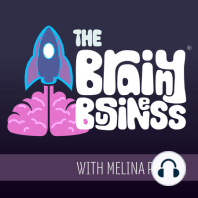47 min listen

71. Prefactual Thinking: How to Turn “What If” Into “Why Not” - Behavioral Economics Foundations
FromThe Brainy Business | Understanding the Psychology of Why People Buy | Behavioral Economics
71. Prefactual Thinking: How to Turn “What If” Into “Why Not” - Behavioral Economics Foundations
FromThe Brainy Business | Understanding the Psychology of Why People Buy | Behavioral Economics
ratings:
Length:
27 minutes
Released:
Oct 25, 2019
Format:
Podcast episode
Description
You may remember episode 68 on counterfactual thinking (why we ‘what if’ and ‘if only’). That episode and the Inc.com article I wrote on how to break the negative cycle of 'what if' thinking were incredibly well received. That episode talked about the different types of counterfactuals – upward or downward, omission or commission, and usual or extreme. Today, I’m going to build on that and talk about the difference between a prefactual and a counterfactual. I’ll explain how they can work differently to help you achieve goals (building on last week’s episode as well). Goals are so important at this time of year. As the year is ending, you’re looking back at what you have done, what you could have done, and also looking forward at what you can do in the future. This is all counter and prefactual thinking in action, and as I’ve already said, they can be a huge aid in reaching goals…or a massive hinderance. Understanding how they work is a big step toward being able to use them to your advantage, and that’s really the point of this episode. Before we jump in, I want to remind everyone that the cart for the Brainy Mindset Course is now open! Claim your spot by November 1st. The first of our six weekly live training sessions begins on November 5th. There are also lots of worksheets and a dedicated Facebook community where I will also be answering your questions. It’s going to be amazing, and we already have some fantastic people signed up and interacting in the group and getting a jump on things. Another amazing thing is that it’s only $199 for the entire six week course, which will give you all the steps to tackle mindset including live support with me walking through it with you every step of the way. To make things extra sweet for you podcast listeners, there is an extra bonus of 25% off. This brings the total down to only $149 if you use the code BRAINY50OFF at checkout. Sign up now! Show Notes: [06:05] Counterfactuals are looking back at something that has already happened, and essentially undoing it in some way in your mind. [06:19] Ruminating isn’t the same as a counterfactual. Memory reflection itself isn’t enough…you need to change what happened or could have happened in your brain for it to be a counterfactual thought. [06:39] Prefactuals are when you look to the future, and think about what could be. Like counterfactuals, this can either be negative positive. [06:49] If you look to the future in a negative way, it has been called “defensive pessimism” and may involve anticipation of regret and building strategies to avoid that. [07:27] When you think about what could happen or how you might succeed in the future, studies show you can actually have great benefits in all sorts of tasks. [08:25] The brain does get benefit from dwelling and dread. [08:51] Your brain loves dopamine and it drives it to do all sorts of things. Anticipation is at the core of prefactual thinking. [09:48] The treat for the brain is in the pre-buildup or the prefactual. [10:31] I decided to send a Gratitude Discount to people on my mailing list for my Brainy Course, unfortunately there was an email mistake and about a dozen people received %firstname% instead of their name. [13:06] I could dwell on this for hours in the counterfactual/prefactual world. [14:37] Counterfactuals tend to focus on things that we really have no control over. [14:57] Prefactuals are more likely to focus on things in your realm of control. [15:33] Instead of just predicting the possible future outcome, you want to identify a specific circumstance. [16:19] My 10/10/80 A/B test gave me a chance to think a little about what could happen (prefactual) and because I didn’t dwell too much on what might have been (counterfactual) I could take steps to actually make it better. [18:46] I also used the power of prefactual thought to prevent this from happening again. [19:41] One key to using counterfactuals and prefactuals for your benefit, is to look for the learning opportunity
Released:
Oct 25, 2019
Format:
Podcast episode
Titles in the series (100)
10. On Air Strategy Planning Session with Mariel Court: In this behavioral economics podcast it is time to apply what I have been talking about in the first 9 episodes through this very first on air strategy session, featuring my guest Mariel Court. Mariel is someone I met in the BizChix Coop (which is... by The Brainy Business | Understanding the Psychology of Why People Buy | Behavioral Economics